Museum is an international non-profit-making organization and institution. The museum activities are governed and directed by the International Council of Museums (ICOM). In 2022, ICOM came up with a working and all-encompassing definition of museums as a not-for-profit permanent institution in the service of the society that researches, collects, conserves, interprets and exhibits tangible and intangible heritage open to the public accessible and inclusive museum fosters diversity and sustainability.
Going by the above definition, museum is set up to serve the society [the people] by researching into the people’s past, collecting historical evidence of their culture, conserving [preserving] same and exhibiting them for public view and entertainment. The museum also provides easy accessibility for the people to get into contact with their past through the exhibition of their tangible and intangible heritage, caters for the divergent classes, creating a sense of inclusiveness.
The museum is not an island unto itself, it works harmoniously with its host communities to ensure national development. For instance, in places where museums are sited, the indigenes are employed; it creates room for some businesses to thrive, recreational facilities and fun centres are created. This brings fun and relaxation to the people thereby enhancing their emotional and psychological wellbeing.
The museum encourages the promotion of tangible and intangible cultural exchanges of rich cultural endowment of various communities and ethnic nationalities. It helps in solidifying relationships between and among the people. The museum sponsors researches into various aspects of the culture of the people. Through these, the people’s past is reflected and where there is the need to polish it to make it more relevant to the present, the necessary machinery is put in motion. Through cultural exchange, capacity building evolves. This provides opportunities for collaboration and enhancing better and effective service delivery to the people. Also the people [the host community] are usually being carried along in policy formulation and execution as they are beneficiaries of some of these policies.
The museum helps in ensuring the promotion of peace and unity within the host community. The museum through ethnographic researches helps in promoting unity in diversity and creating social harmony. This it does through collection and exhibition of the people’s material and non-material culture evidences.
Furthermore, through the museum collection, vistas of cultural co-operation are opened by projecting the good aspects of the people’s culture, norms, values and integrity through exhibitions in galleries. This also helps in promoting social harmony between and among the people of the various communities within and outside the host communities.
Moreover, the museum helps in promoting youth and community development. In most museums especially those in the rural areas, the youths and community members provide good security for the museums. It provides some level of employment for the people; their minds and attention are arrested and focused for useful purposes. Crime and criminalities are greatly reduced giving room for peace and progressive development.
Most of the museum collections and exhibitions draw the attention of the youth without recourse to their various cultural heritage, values and socio-cultural perception of what is right and wrong. Museum provides people from different backgrounds a conducive environment for love and co-operation. When people from diverse socio-cultural backgrounds meet, there is cross-fertilization of ideas; new values and virtues can be inculcated or learnt. These are keys to social integration and national development.
The museum obviously exposes the youth and community members of the host communities to acquiring positive virtue of hard work, industry, honesty and patriotism. These are evident in the works of the museum educators who usually organize talk shows, seminars, workshops and symposia during which the people are educated and taught on various topical issues. The education unit of the museum also visit schools where they teach the pupils/students crafts and other trades such as fashion designs, pottery, tie & dye, bead making, basket making, etc. This does not only help in arresting their young minds but also equips them with knowledge that will in the near future enhance their economic potentials and viabilities as well as self sustaining ability.
Museum provides room for economic empowerment for the people. There are some people or communities that are very good in production of craft and gift items [homemade]. Many visitors that come to the museum often visit these craft shops some of which are located either in the museum premises or outside the museum to buy some of these items, thereby creating a ready market for their products and enhancing their economic viability. Many people especially the youths are now getting more interested. The Benin Museum at the King’s Square has greatly impacted on the production and sales of bronze items at Igun Quarters. The Benin Museum is in close synergy with the Igun guild of bronze casters.


